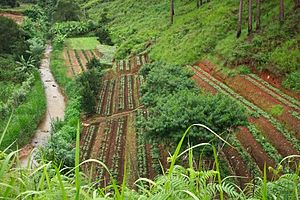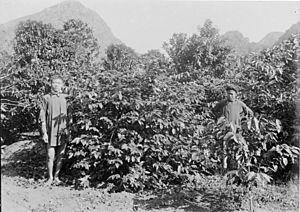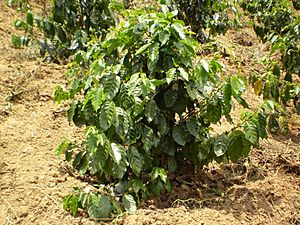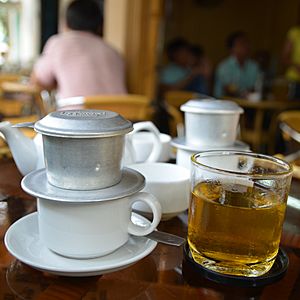Coffee production in Vietnam facts for kids
Coffee has been a very important product for Vietnam for a long time. The French first brought coffee plants to Vietnam in 1857. Over time, coffee farms grew into a big industry. It became a major part of Vietnam's economy. After the Vietnam War, coffee production slowed down. But after some economic changes called Đổi mới in 1986, it grew fast again. Now, coffee is the second most valuable farm product Vietnam exports, right after rice.
Contents
History of Coffee in Vietnam
People think French missionaries first brought coffee plants to Vietnam in 1857. But the first large coffee farms started later, in 1888. These were in the Ninh Bình and Quảng Bình areas. At first, most of the coffee grown was a type called Arabica.
Coffee production really grew in the early 1900s. Small farms became bigger commercial plantations. In the 1920s, the French opened more coffee growing areas. These were mainly in the Central Highlands, especially in Đắk Lắk Province. By 1930, Vietnam exported about 1,500 tons of coffee each year. This amount grew to 2,000 tons per year by 1940. The first factory to make instant coffee opened in 1969. It was called Coronel Coffee Plant and could make 80 tons of instant coffee a year.
The Vietnam War made it hard to grow coffee. The main coffee area, Buôn Ma Thuột, was a busy place during the war. Many people left the area. After the war, the government took control of most farms. This meant private businesses were not allowed, and coffee production stayed low.
In 1986, the government made big economic changes called Đổi mới. Private businesses were allowed again. This led to a huge increase in coffee farming. Farmers, producers, and the government worked together. They started branding Vietnamese coffee and selling it to other countries. However, after 1975, many people moved to the Central Highlands. They came from crowded, poor lowland areas to find work in coffee farming.
How Coffee Production Affects Vietnam
Changes in the Coffee Economy
Vietnam is the second largest coffee producer in the world, after Brazil. Most of Vietnam's coffee (97%) is a type called Robusta. But coffee farmers in Vietnam often face big ups and downs in prices. This has happened since the 1980s. When global coffee prices change, importing countries often pay a steady price. But farmers in Vietnam feel the daily price changes a lot.
For example, in 2017, Vietnam produced less coffee than expected. This was because of late rain. Experts predicted more coffee in 2018 and 2019. This was due to better farm management and more private businesses helping. Vietnam's economy grew a lot in 2017 and 2018. But we also need to think about how this growth affects people and the environment.
When coffee prices dropped in 2001, many farming families struggled. They had less food or had to rely on help from the government. When prices were good, children could go to school. Families could buy things like TVs. But when prices fell, children often had to leave school. Farmers who owned their land had to find other jobs.
Poor planning also caused problems. In 2013-2014, there was a huge coffee harvest. This added too much coffee to the world market. Coffee prices fell sharply. Many local coffee export companies had to close. They could not pay back their loans. This showed how risky the coffee business can be.
Social Differences in Coffee Farming
Kinh People vs. Minority Groups
When coffee prices fall, small farmers are hit hard. But not everyone is affected in the same way. This can make existing social differences worse.
Studies have looked at how different groups are affected. The Kinh people are the main ethnic group in Vietnam. Many other smaller ethnic groups also live there, like the Ede. One study looked at the income of Kinh and Ede coffee farmers. It found that Ede farmers often had lower incomes. This was true even though they had bigger farms and grew more coffee.
Data from 2003 suggested why this might be. Ede families often had more people to support. They also used more family members to work on the farms. This unpaid work, often by women and children, could mean lower yields. This is because they might not have the same farming knowledge. Kinh families were smaller and often hired workers. These workers might already know a lot about coffee farming.
Another study looked at how Kinh and Ede families reacted to falling coffee prices. Kinh families were more likely to borrow money or find other jobs. Ede families had larger farms. They could sometimes change crops or move their farms. But they often struggled to get short-term loans. They also found it hard to leave their farms to find other work. Experts suggest that policies should help these groups earn money in different ways.
Migrant Workers
Many people move to the Central Highlands to work in coffee farming. These "migrant networks" help farmers find jobs and get financial support. This help comes from both where they work and from their families back home. For example, Kinh migrants rely on family to look after their children and land back home. This helps them keep their land. Parents and spouses can also take loans using this land. This money can help with farming in the highlands. These connections between different regions are very important. They help people manage risks in the future.
However, moving for work is not always easy. In the past, the government encouraged millions of lowland farmers to move to the highlands. This was not always popular at first. But in the 1980s and 1990s, more people moved on their own. They were looking for economic success. Family networks helped people move. Relatives often offered help in exchange for work. Even family help back home can involve both "mutual aid and mutual exploitation." This means people help each other, but sometimes one person benefits more.
Harm to the Environment
Coffee farming grew a lot in the Dak Lak region. This growth caused some problems for the environment. Forests were cut down, and many different plants and animals were lost. This happened because people wanted to grow more coffee for money. They did not always think about the environmental costs. Farmers also used a lot of fertilizer. They often grew only coffee plants, which can make the soil less healthy. This can also lead to more pests.
A study found that many small farmers are struggling with the environment. Their coffee trees are getting old. Labor costs are rising. Climate change and competition for water are also big problems. Official reports might not always show the full picture. For example, land that is not good for coffee might still be used, but not counted in statistics.
Environmental harm is not the same everywhere. It often depends on social differences. Richer Kinh families might buy land and grow coffee for export. This can push poorer ethnic minority groups to farm closer to forests. So, the changing coffee economy, social differences, and environmental harm are all connected. They are not separate problems.
Steps Towards Sustainable Coffee Production
In 2010, Vietnam created a plan called "The New Vision for Agriculture (NVA)." This plan aimed to make farming more sustainable and productive. It wanted to improve the quality of farm products and help the economy grow. The Vietnamese government added this plan to its national farming strategy in 2011.
A group focused on coffee was one of the first projects. Many big coffee companies worked with the government, non-profit groups, and farmers. They worked together to replace old coffee trees. They also provided training and financial help to farmers.
The Coffee Coordination Board (CCB)
This working group later became the Coffee Coordination Board (CCB) in 2013. Since then, more research has focused on how the government helps. For example, a study in Dak Lak showed how coffee management changed. It went from a weak system to one led by the CCB. The CCB now helps farmers with social, economic, and environmental risks. It provides resources, education, and training.
One important project was helping farmers replant coffee trees. Experts thought that if farmers did not replant, Vietnam's coffee production would drop a lot by the mid-2020s. But replanting takes a long time. Farmers might earn less money for several years. So, the government also created ways to help farmers with money during this time.
However, these plans were sometimes hard to put into action. For example, the government offered money to farmers who used new methods to reduce water pollution. But many farmers were slow to adopt these methods. This was because there were no penalties if they did not. Improvements are needed to encourage farmers more. The CCB and government have started to use ideas from researchers. These include growing different crops and using eco-friendly farming. But access to the CCB's programs is still unequal. They often help the Kinh majority more than ethnic minorities in the Highlands.
Fair Trade Coffee Certification
Another way to help farmers is through international "fair trade" certifications. These include labels like Nestle's 4C, UTZ, and Rainforest Alliance. Fair Trade aims to help producers directly. It is well-known by many consumers in countries like the United States and Europe.
In Vietnam, these certifications help the country show its coffee to the world market. They also help keep coffee export money coming in.
Some people say fair trade coffee creates an idea that consumers are the most important helpers. They believe that buying fair trade products helps farmers. But in Vietnam, the government still plays a big role in fair trade. The government wants to show that coffee provides jobs and money for the country. It also wants to encourage private farmers to join the global market. These efforts helped the coffee industry grow. But we cannot ignore the negative effects on society and the environment. Still, making more coffee and being efficient can help reduce poverty. This can be true even if it goes against some eco-friendly methods.
A main criticism of fair trade is that it can show images of poverty. This makes consumers feel like they are saving poor farmers. But addressing climate change needs global action. It should not just be the responsibility of Vietnamese farmers.
Fair trade is important to many people in the world today. It is a way to be aware of products from "developing" countries like Vietnam. For Vietnamese coffee farmers, certifications can help them show the quality of their coffee. They can also help them share their ideas about fair trade. Certifications also help people recognize Vietnamese coffee quality. For example, Robusta coffee is sometimes seen as less good than Arabica. But certifications can change this view.
This often happens through audits. These checks provide proof for consumers and investors. This is a new thing for Vietnamese farmers since the Doi Moi changes. They have to learn how to work with these audits to earn more money. Many Vietnamese farmers want their coffee quality to be recognized. Companies like Trung Nguyên, a top Vietnamese coffee brand, market their instant coffee as being from "Vietnam’s legendary basaltic region." This region is so famous that tourists visit coffee farms and museums there.
Vietnamese Coffee in the World
Starbucks opened its first store in Vietnam in 2013. This started a trend for other global coffee companies to follow. In 2017, Boncafé, a European gourmet coffee producer, opened a showroom and factory in Vietnam.
In the US, there are rules about labeling where products come from. But coffee is often changed during processing. So, there is no rule to label Vietnamese coffee as "Made in Vietnam."
Sometimes, Vietnamese-style coffee in the US is confused with coffee from Louisiana. Louisiana coffee is often brewed with French roast coffee and chicory. Vietnamese immigrants in Louisiana used this coffee because they could not get Vietnamese-grown coffee. The French roast style was similar to Vietnamese coffee in how it was ground. This made it a good substitute for traditional brewing. But in Vietnam, local coffees are roasted differently and do not have chicory.
Since the economic changes of Đổi mới, Vietnamese coffee now competes globally. It faces different laws, cultures, tastes, and business ways around the world.
Vietnamese Coffee Style
Vietnamese coffee, especially from the Buôn Mê Thuột region, has special features:
- The coffee growing areas have different climates. Several types of coffee are grown there. These include Arabica, Robusta, and Chari (also called Excelsa). Some Arabica types are Catimor and some local varieties. Vietnamese coffee makers blend different beans. This creates unique flavors or helps lower costs.
- Coffee is usually made one cup at a time. It uses a special metal filter called a phin. The coffee is often served while it is still brewing. Sweetened condensed milk is used instead of fresh milk. This is because it was easier to get and store in a hot climate. The condensed milk makes the coffee sweet and balances its strong flavor. This has become the preferred taste in Vietnam.
- The coffee can be brewed over ice to make cà phê đá. If it has condensed milk and ice, it is called cà phê sữa đá.






